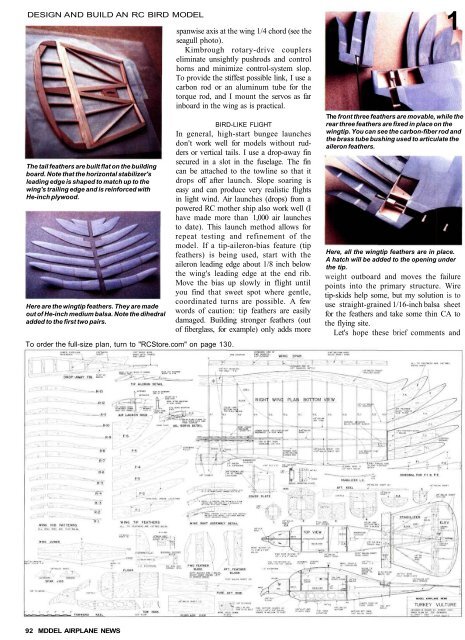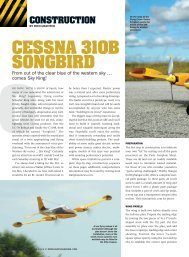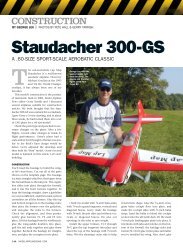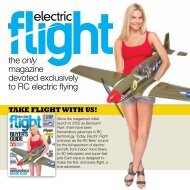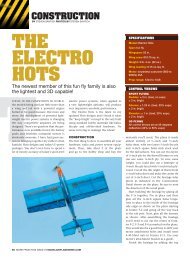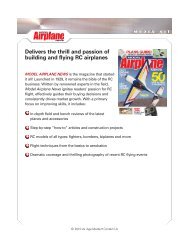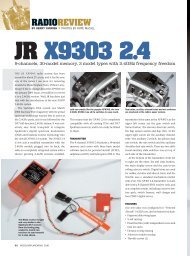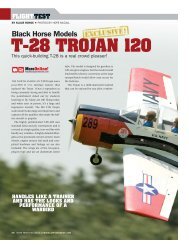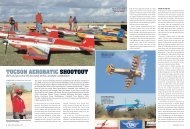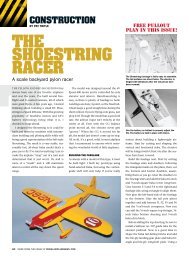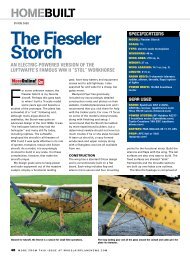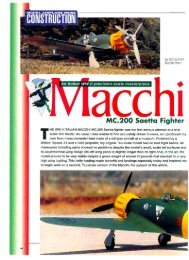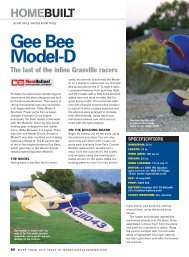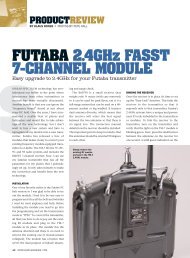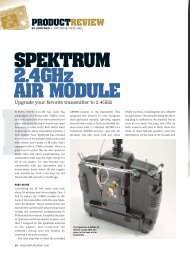Create successful ePaper yourself
Turn your PDF publications into a flip-book with our unique Google optimized e-Paper software.
DESIGN AND BUILD AN RC BIRD MODEL<br />
The tail feathers are built flat on the building<br />
board. Note that the horizontal stabilizer's<br />
leading edge is shaped to match up to the<br />
wing's trailing edge and is reinforced with<br />
He-inch plywood.<br />
Here are the wingtip feathers. They are made<br />
out of He-inch medium balsa. Note the dihedral<br />
added to the first two pairs.<br />
To order the full-size plan, turn to "RCStore.com" on page 130.<br />
92 MDDEL AIRPLANE NEWS<br />
spanwise axis at the wing 1/4 chord (see the<br />
seagull photo).<br />
Kimbrough rotary-drive couplers<br />
eliminate unsightly pushrods and control<br />
horns and minimize control-system slop.<br />
To provide the stiffest possible link, I use a<br />
carbon rod or an aluminum tube for the<br />
torque rod, and I mount the servos as far<br />
inboard in the wing as is practical.<br />
BIRD-LIKE FLIGHT<br />
In general, high-start bungee launches<br />
don't work well for models without rudders<br />
or vertical tails. I use a drop-away fin<br />
secured in a slot in the fuselage. The fin<br />
can be attached to the towline so that it<br />
drops off after launch. Slope soaring is<br />
easy and can produce very realistic flights<br />
in light wind. Air launches (drops) from a<br />
powered RC mother ship also work well (I<br />
have made more than 1,000 air launches<br />
to date). This launch method allows for<br />
repeat testing and refinement of the<br />
model. If a tip-aileron-bias feature (tip<br />
feathers) is being used, start with the<br />
aileron leading edge about 1/8 inch below<br />
the wing's leading edge at the end rib.<br />
Move the bias up slowly in flight until<br />
you find that sweet spot where gentle,<br />
coordinated turns are possible. A few<br />
words of caution: tip feathers are easily<br />
damaged. Building stronger feathers (out<br />
of fiberglass, for example) only adds more<br />
1<br />
The front three feathers are movable, while the<br />
rear three feathers are fixed in place on the<br />
wingtip. You can see the carbon-fiber rod and<br />
the brass tube bushing used to articulate the<br />
aileron feathers.<br />
Here, all the wingtip feathers are in place.<br />
A hatch will be added to the opening under<br />
the tip.<br />
weight outboard and moves the failure<br />
points into the primary structure. Wire<br />
tip-skids help some, but my solution is to<br />
use straight-grained 1/16-inch balsa sheet<br />
for the feathers and take some thin CA to<br />
the flying site.<br />
Let's hope these brief comments and


